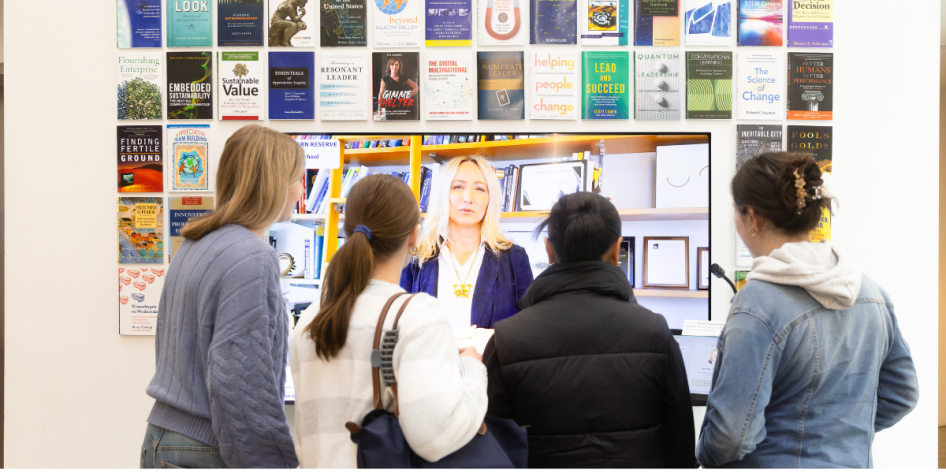Engaging beyond the classroom
Bringing Weatherhead thought leaders to life with artificial intelligence
Visitors to Weatherhead School of Management now have a new way to interact with faculty members and thought leaders at the school—by speaking with their virtual avatars.
“A reporter doing a feature on the school was blown away by our innovative approach to education and technology leadership, and asked to see a physical representation of AI,” said Dean Andrew Medvedev. “We realized right then and there that expression of our work is indeed worth 1,000 words, and what better to serve their purpose than a project by our students and faculty.”
Set up in the lobby of the Peter B. Lewis Building, the kiosk features a large screen, touchscreen and microphone. Around the screen are printed covers of published works by faculty at Weatherhead, some of which inform the avatars' interactions with users.
Led by second-year MBA student Ruihuang Yang, a group of students, including Aadhav Bharadwaj, Jason Li, Joseph Falkenburg and Sahith Jalapally, spent the summer building the program, which involved integrating multiple systems to produce the full-fledged avatars.
“We used some of the latest technologies to build the program,” said Yang. “Because it is a physical kiosk, it involves not only software but also a set of hardware, so we had to build a holistic experience for users of the system.”

Weatherhead faculty including John Paul Stephens are among the avatars.

Visitors can engage with the screen in the lobby of the Peter B. Lewis Building.

Virtual avatars are accessible through the display's touchscreen.

The experience is a valuable touchpoint for Weatherhead students of all disciplines.
The physical pieces of the project were one hurdle for the team, who had to determine where the screen would be placed, what hardware would be required, and how all of the different elements would best fit together. The system is built to run continuously, which posed challenges for the student developers.
Piecing the puzzle together also required using a variety of preexisting softwares, including OpenAI and a software to record each faculty member and generate their digital avatar. The project involved some original coding as well, including a system to ensure that the avatars would stick to appropriate and relevant topics.
“We built in some guardrails so the avatars stay focused on thoughtful and relevant conversations,” said Stefan Agamanolis, executive director of xLab, which supported the project. “They will talk about their research. They'll talk about courses and student life at Weatherhead. They'll talk about Case Western Reserve and Cleveland more generally. They can even talk about where's a good place to get a pizza.”
The avatars, which currently include Jenny Hawkins, Michael Goldberg, John Paul Stephens and Richard Boyatzis, channel the knowledge of these thought leaders and provide a way for students and visitors to engage outside of the classroom. It’s been so well-received that students are using it to connect with communities around the world.
“The coolest part for me is that the avatars can speak in 20 different languages,” said Yang. “We actually saw people from all parts of the world using the program in their native languages and taking videos to send back to their friends and family. It’s been very gratifying to sit near the kiosk and watch students and visitors interact with the program that I helped develop. It gives me a huge sense of accomplishment.”




